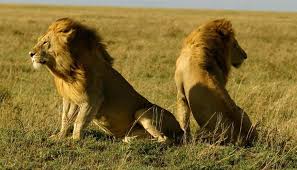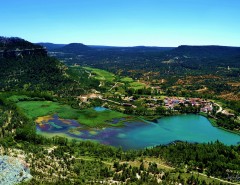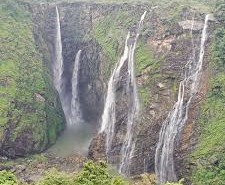The Gir Forest National Park and Wildlife Sanctuary (also known as Sasan-Gir, and गिर वन) is a forest and wildlife sanctuary near Talala Gir in Gujarat, India. Established in 1965, with a total area of 1,412 km2 (545 sq mile) (about 258 km2 (100 sq mile) for the fully protected area of the national park and 1,153 km2 (445 sq mile) for the Sanctuary, the park is located 43 km (27 mile) north-east of Somnath, 65 km (40 mile) south-east of Junagadh and 60 km (37 mile) south-west of Amreli.
Its region is the sole home of the Asiatic lion (Panthera leo persica) in the wilderness, and is considered to be one of the most important protected areas in Asia due to its supported species. The ecosystem of Gir, with its diverse flora and fauna, is protected as a result of the efforts of the government forest department, wildlife activists and NGOs. The forest area of Gir were the hunting grounds of the Nawabs of Junagadh. However, faced with a drastic drop in the lion population in Gir, Nawab Sir Muhammad Rasul Khanji Babi declared Gir as a “protected” area in 1900. His son, Nawab Muhammad Mahabat Khan III later assisted in the conservation of the lions whose population had plummeted to only 20 through slaughter for trophy hunting.
The 14th Asiatic Lion Census 2015 was conducted in May 2015. In 2015, the population has been 523 (27% up compared to previous census in 2010). The population was 411 in 2010 and 359 in 2005. The population of lions in Junagadh District has been 268, Gir Somnath District has been 44, Amreli District has been 174 (highest increase) and Bhavangar District has been 37. There are 109 males, 201 females and 213 young/cubs.
Geography
Water reserves
The seven major perenninal rivers of the Gir region are Hiran, Shetrunji, Datardi, Shingoda, Machhundri, Godavari and Raval. The four reservoirs of the area are at four dams, one each on Hiran, Machhundri, Raval and Shingoda rivers, including the biggest reservoir in the area, the Kamleshwar Dam, dubbed ‘the lifeline of Gir’. It is located at 21°08′08″N 70°47′48″E.
During peak summer, surface water for wild animals is available at about 300 water points. When drought hits the area following a poor rainfall, surface water is not available at a majority of these points, and water scarcity becomes a serious problem (mainly in the eastern part of the sanctuary). Ensuring the availability of water during peak summer is one of the major tasks of the Forest Department staff .
Flora
More than 400 plant species were recorded in the survey of Gir forest by Samtapau & Raizada in 1955. The Botany department of M.S. University of Baroda has revised the count to 507 during their survey. According to the 1964 forest type classification by Champion & Sheth, the Gir forest falls under “5A/C-1a—very dry teak forest” classification. Teak occurs mixed with dry deciduous species. The degradation stages (DS) sub-types are thus derived as:
1. 5/DS1-Dry deciduous scrub forest and
2. 5/DS1-Dry savannah forests (Locally known as “vidis”). It is the largest dry deciduous forest in western India.
Teak bearing areas are mainly in the eastern portion of the forest, which constitutes nearly half of the total area.Several species of acacia are found. Also found here are ber,jamun,babul,flame of the forest,zizyphus,tendu and dhak. Also plants like karanj,umlo,amli,sirus,kalam,charal and an occasional vad or banyan tree are found.These broadleaf trees provide a cool shade and moisture content to the region.As part of the afforestation programme cassuarina and prosopis have been planted along the coast borders of gir.
The forest is an important biological research area with considerable scientific, educational, aesthetic and recreational values. It provides nearly 5 million kilograms of green grass by annual harvesting, which is valued approximately at Rs. 500 million (US$10 million). The forest provides nearly 123,000 metric tons worth of fuel wood annually.
Wildlife
The count of 2,375 distinct fauna species of Gir includes about 38 species of mammals, around 300 species of birds, 37 species of reptiles and more than 2,000 species of insects. The carnivores group mainly comprises Asiatic lions, Indian leopards, Indian cobras, jungle cats, striped hyenas, golden jackals, Indian mongoose, Indian palm civets, and honey badgers. Desert cats and rusty-spotted cats occur but are rarely seen.
The main herbivores of Gir are chital, nilgai, sambar, four-horned antelope, chinkara and wild boar. Blackbucks from the surrounding area are sometimes seen in the sanctuary. Among the smaller mammals, porcupine and hare are common, but the pangolin is rare. The reptiles are represented by the marsh crocodile, tortoise and monitor lizard which inhabit the sanctuary’s bodies of water. Snakes are found in the bush and forest. Pythons are sighted at times along the stream banks. Gir has been used by the Gujarat State Forest Department which formed the Indian Crocodile Conservation Project in 1977 and released close to 1000 marsh crocodiles into Lake Kamaleshwar and other small bodies of water in and around Gir.
The plentiful avifauna population has more than 300 species of birds, most of which are resident. The scavenger group of birds has 6 recorded species of vultures. Some of the typical species of Gir include crested serpent eagle, endangered Bonelli’s eagle, crested hawk-eagle, brown fish owl, Indian eagle-owl, rock bush-quail, Indian peafowl, brown-capped pygmy woodpecker, black-headed oriole, crested treeswift and Indian pitta. The Indian grey hornbill was not found from the last census of 2001.
- Country – India
- State – Gujarat
- District – Somnath
- Area – 1,412 km2 (545 sq mile)
- Nearest city– Talala (Gir)
- Established – 1965




